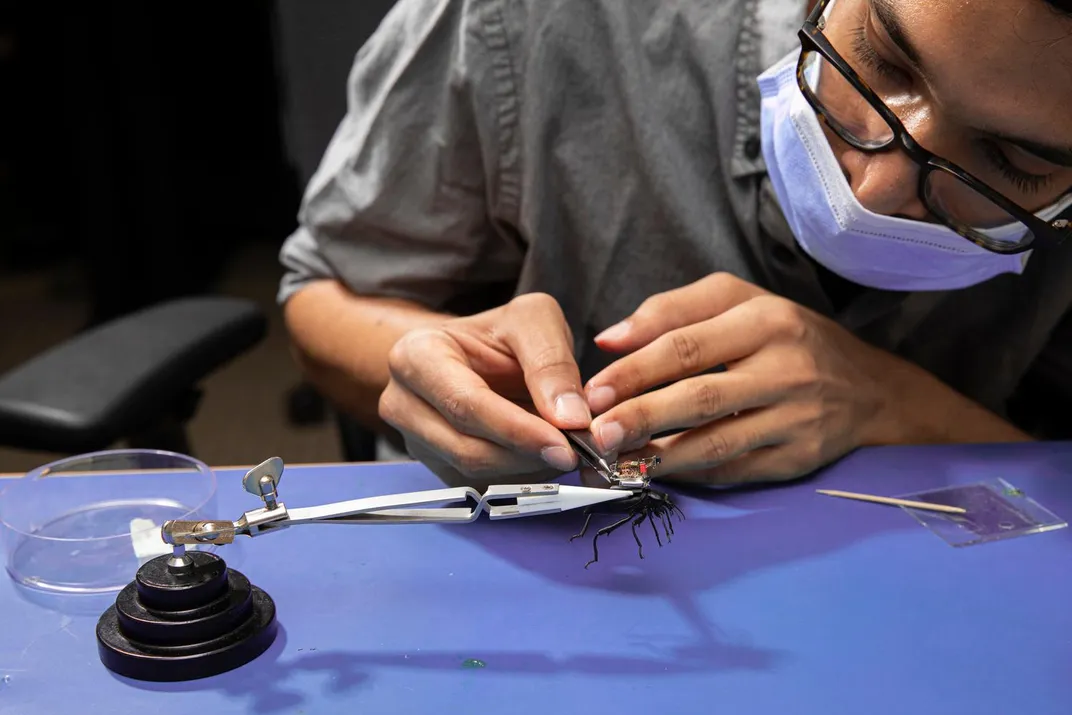Beetles Wearing Tiny, Robotic Camera Backpacks Give Bugs-Eye View of the World
The wireless, lightweight and steerable device expands the possibilities for miniature cameras
:focal(535x421:536x422)/https://tf-cmsv2-smithsonianmag-media.s3.amazonaws.com/filer/d5/14/d51414c3-ed54-44dc-9081-f76853cc97be/beetlecameraweb009.jpg)
To understand the world at the scale of a bug, a team of scientists decided to see like one.
By studying the way insects’ eyes and head movements, they created a tiny robotic camera to ride on a beetle’s back. In a study published Wednesday in Science Robotics, researchers explain how their work tests the limits of miniature cameras.
Essentially a GoPro for beetles, the device is “a fully wireless, power-autonomous, mechanically steerable vision system,” the researchers write. The camera sits atop a robotic arm that can move up to 60 degrees and capture panoramic shots or track moving objects.
"Vision is so important for communication and for navigation, but it's extremely challenging to do it at such a small scale. As a result, prior to our work, wireless vision has not been possible for small robots or insects,” University of Washington engineer Shyam Gollakota, senior author, tells Sarah McQuate of University of Washington News.
The camera is extremely lightweight, measuring about 250 milligrams, or “around one-tenth the weight of a playing card,” according to Rob Picheta of CNN.
Vision for insects can demand high amounts of energy, so many develop systems in which the head moves independently of the body. So, instead of having advanced peripheral vision which requires lots of energy, the bug simply turns its head for a higher resolution look.
The researchers’ camera mimics insect head movement to cut down on energy usage and maintain balance. The tiny camera is attached to a mechanical arm that scientists can steer to direct the camera at a certain object, or to get a wider view. This way, the shot is higher resolution than it would be if the camera had an energy-sapping, wide-angle lens.
“By combining these two different things – living animals with sensors – you’re basically getting the best of both worlds,” Gollakota tells Donna Lu of New Scientist.

The camera is powered by a lithium polymer battery and can stream continuously for over an hour. Scientists can also program the camera to only capture footage when the beetle is moving, as sensed with an accelerometer, increasing battery life up to six hours. For future versions, researchers are looking to use other power sources, CNN reports.
The camera captures monochromatic “first-person” footage at a resolution of 160-by-120 pixels, at a rate or between one and five frames per second. The video is transmitted via Bluetooth to a smartphone and can be controlled from up to 120 meters away, or just over the length of a football field, according to UW News.
For this test, two species of beetles were outfitted: the death-feigning beetle (asbolus laevis) and the pinacate bettle (Eleodes nigrina). Researchers reported all the test beetles remained alive a year after the experiment.
There is currently no way to control the beetles’ movement. But researchers are hoping that they can outfit many more beetles to more thoroughly map environments.
“As they spread out you can collect enough information that you don’t need to control the insects,” Gollakota tells New Scientist.
The camera could be used to explore and map remote environments or help biologists understand movement in certain terrains.
"There are so many questions you could explore, such as how does the beetle respond to different stimuli that it sees in the environment?" co-lead author Vikram Iyer tells UW News. "But also, insects can traverse rocky environments, which is really challenging for robots to do at this scale. So, this system can also help us out by letting us see or collect samples from hard-to-navigate spaces."
Creating such a powerful camera that is so light and virtually undetectable raises questions about the implications for covert surveillance. The scientists acknowledge the privacy concerns.
"As researchers we strongly believe that it's really important to put things in the public domain so people are aware of the risks and so people can start coming up with solutions to address them," Gollakota tells CNN.
In addition to the camera-laden beetles, the team developed a small robot with steerable vision that allows them to track objects with 26 to 84 times lower energy than moving the whole robot. Their work could provide a key step in making more functional miniature robots.
/https://tf-cmsv2-smithsonianmag-media.s3.amazonaws.com/accounts/headshot/IMG_1578_copy_copy.jpg)


/https://tf-cmsv2-smithsonianmag-media.s3.amazonaws.com/accounts/headshot/IMG_1578_copy_copy.jpg)